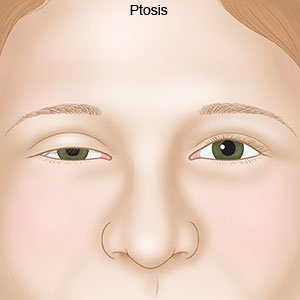Ptosis
Medically reviewed by Drugs.com. Last updated on Apr 2, 2024.
What is ptosis?
Ptosis is the drooping of one or both eyelids. It may affect your vision. You may tilt your head back to see underneath the drooping eyelid. You may also try to lift your eyelids by raising your eyebrows.
 |
What causes ptosis?
- Poor development of the levator muscle (muscle that lifts the eyelid) present at birth
- Weakening or detachment of the levator muscle that occurs with aging, trauma, or eye surgery
- Conditions that affect the nerves of the eye such as Horner syndrome
- Conditions that affect the muscles such as myasthenia gravis or muscular dystrophy
- Swelling caused by a foreign body or tumor that makes the eyelid heavy
How is ptosis diagnosed?
Your healthcare provider will examine your eyes, your eyelids, and check your vision. Your provider will ask when the ptosis occurred and how long you have had it. Tell your provider about any other symptoms or medical conditions you have. You may need other tests to find the cause of your ptosis.
How is ptosis treated?
You may not need any treatment if your ptosis is mild. Treatment for the cause of your ptosis may be needed. If your ptosis is affecting your vision, you may need surgery. Surgery may be done to tighten your levator muscle or to reattach it. If your levator muscle is too weak, your eyelid may be attached to or suspended from the area under your eyebrow. This will allow your forehead muscles to do the work of lifting your eyelid.
Treatment options
The following list of medications are related to or used in the treatment of this condition.
When should I contact my healthcare provider?
- Your vision gets worse.
- You have new symptoms.
- You have questions or concerns about your condition or care.
Care Agreement
You have the right to help plan your care. Learn about your health condition and how it may be treated. Discuss treatment options with your healthcare providers to decide what care you want to receive. You always have the right to refuse treatment. The above information is an educational aid only. It is not intended as medical advice for individual conditions or treatments. Talk to your doctor, nurse or pharmacist before following any medical regimen to see if it is safe and effective for you.© Copyright Merative 2024 Information is for End User's use only and may not be sold, redistributed or otherwise used for commercial purposes.
Learn more about Ptosis
Treatment options
Symptoms and treatments
Further information
Always consult your healthcare provider to ensure the information displayed on this page applies to your personal circumstances.
